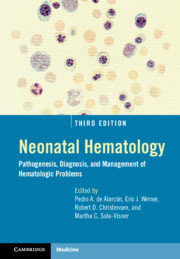Book contents
- Neonatal Hematology
- Neonatal Hematology
- Copyright page
- Contents
- Foreword
- Preface
- Contributors
- Section I Developmental Hematology
- Section II Bone Marrow Failure and Immune Disorders
- Section III Erythrocyte Disorders
- Section IV Platelet Disorders
- Chapter 12 Approach to the Thrombocytopenic Neonate
- Chapter 13 Acquired Thrombocytopenias
- Chapter 14 Fetal and Neonatal Alloimmune Thrombocytopenias
- Chapter 15 Congenital Thrombocytopenias and Thrombocytopathies
- Section V Leucocyte Disorders
- Section VI Hemostatic Disorders
- Section VII Neonatal Transfusion Medicine
- Section VIII Neonatal Oncology
- Section IX Miscellaneous
- Index
- Plate Section (PDF Only)
- References
Chapter 14 - Fetal and Neonatal Alloimmune Thrombocytopenias
from Section IV - Platelet Disorders
Published online by Cambridge University Press: 30 January 2021
- Neonatal Hematology
- Neonatal Hematology
- Copyright page
- Contents
- Foreword
- Preface
- Contributors
- Section I Developmental Hematology
- Section II Bone Marrow Failure and Immune Disorders
- Section III Erythrocyte Disorders
- Section IV Platelet Disorders
- Chapter 12 Approach to the Thrombocytopenic Neonate
- Chapter 13 Acquired Thrombocytopenias
- Chapter 14 Fetal and Neonatal Alloimmune Thrombocytopenias
- Chapter 15 Congenital Thrombocytopenias and Thrombocytopathies
- Section V Leucocyte Disorders
- Section VI Hemostatic Disorders
- Section VII Neonatal Transfusion Medicine
- Section VIII Neonatal Oncology
- Section IX Miscellaneous
- Index
- Plate Section (PDF Only)
- References
Summary
Fetal and neonatal alloimmune thrombocytopenia (AIT) is the most common cause of severe thrombocytopenia in fetuses and neonates [1]. Maternal IgG alloantibodies against paternally derived fetal platelet antigens cross the placenta early in pregnancy and commonly result in severe thrombocytopenia. While the reported incidence varies somewhat with the assigned threshold of thrombocytopenia (50, 100, or 150 × 109/L), in most unselected populations AIT affects 1 in 1,000 live births. Table 14.1 displays the studies of AIT in unselected populations, systematically screened. In its severe form, AIT has the potential for significant morbidity (including intracranial hemorrhage in utero) and mortality. In milder forms, there are either antibodies with no thrombocytopenia, or mild to moderate thrombocytopenia, which is identified only by a complete blood count obtained for another indication or in a screening study. While there have been extensive efforts made in the diagnosis and characterization of the disease, strategies for early detection and intervention remain controversial.
- Type
- Chapter
- Information
- Neonatal HematologyPathogenesis, Diagnosis, and Management of Hematologic Problems, pp. 223 - 242Publisher: Cambridge University PressPrint publication year: 2021

